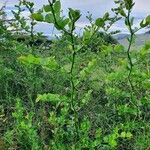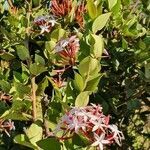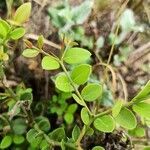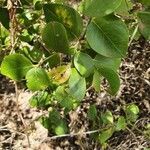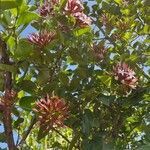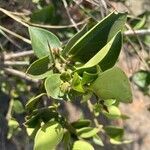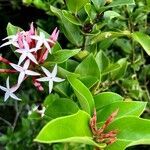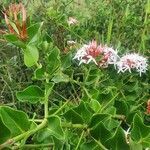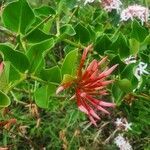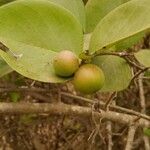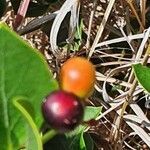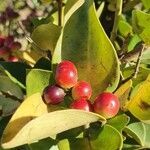Shrub or small tree to 5 m tall, or a liana. Branchlets glabrous to puberulent; spines simple or branched, sometimes slightly recurved. Leaves: petiole 1.5-5 mm long; blade coriaceous, ovate, 1.4-12.2 by 0.8-6 cm, 1.5-2.8 times as long as wide, elliptic, obovate or orbicular, apex weakly retuse to acuminate, apiculate or mucronate, base cuneate to rounded, glabrous to pubescent above and beneath, 2-8 pairs of secondary veins, strongly ascending, tertiary venation obliquely scalariform or reticulate. Inflorescence 1.4-3 cm long, terminal and/or axillary; peduncle 0.2-1.8 cm long, glabrous or puberulent; pedicels 2-4.5 mm long. Flowers fragrant. Sepals ovate to narrowly ovate, 1.5-3 by 0.4-1.5 mm, 2.1-3.8 times as long as wide, apex acute to acuminate; glabrous, rarely sparsely puberulent, ciliate. Corolla white; tube 8-21.5 mm long, 1.4-2.7 times as long as lobes, 3.6-5 times as long as calyx, glabrous or pubescent at top of tube outside, pubescent inside; lobes 2.8-15 by 1.1-2.4 mm, 4.1-6.4 times as long as wide, ovate or oblong, apex acuminate to acute, glabrous to puberulent outside and inside, lobes ciliate. Stamens inserted at 0.7-0.8 of corolla tube length from base; filaments 0.2-0.5 mm long; anthers 1-2.5 by 0.3-0.7 mm. Ovary 0.5-1.5 mm long, glabrous or weakly papillose; style and style head 3-11.4 mm long. Fruit ovoid or subglobose, 0.6-2.5 cm by 4-15 mm; glabrous.
Shrub, sometimes straggling or scandent, up to 4 m high, spiny, much branched, young branches glabrous or tomentose, sap milky; spines simple, rigid, usually straight, 2-4 cm long. Leaves coriaceous, ovate to ovate-elliptic or ovate-lanceolate, rarely subrotund, 2.5-6 cm long and 1.8-3 cm broad, rounded or subcuneate at the base, apex acute and often mucronulate, rarely obtuse, usually paler below, glabrous or pubescent; secondary nerves 3-5 on each side, indistinct; petiole 1-4 mm long, channelled above; axillary glands present, very small; stipules 0. Inflorescence corymbose; bracts linear, 3 mm long, caducous. Flowers white, tinged with purple, subsessile, scented. Calyx 3-4 mm long, pubescent; sepals 5, lanceolate, acuminate. Corolla salver-shaped; tube cylindric, widest near the apex, 1.3-1.8 cm long glabrous without, hairy within; lobes ovate-oblong to oblong-lanceolate, acute, 4-9 mm long, overlapping to the right, pubescent above. Stamens 5, inserted towards the apex; anthers subsessile, 2 ram long. Ovary entire, 2-chambered with 2 ovules per locule; style filiform, 8-10 mm long; stigma elliptic, apex hairy. Fruit a berry, subglobose to ovoid, 6-11 mm in diameter, purple to black, edible. Seeds 2-4, flat, ovoid; testa rough, hard.
Shrub 0.2–3 m, occasionally scrambling up to 20 m high; bark grey, slightly rough or smooth; spines simple, rarely forked, 0.5–6.2 cm long.. Leaves petiolate; petiole 0.5–6 mm long; blade ovate, elliptic or almost orbicular, 1–8(–17) cm long, 0.5–6 cm wide, acute or rounded at the apex, with or without a hard mucro, cuneate or rounded at the base, glabrous or pubescent, with 3–5 pairs of secondary veins.. Inflorescence terminal or occasionally axillary, dense-flowered cymes.. Flowers fragrant, white inside, pink to red outside; sepals (narrowly) ovate, 1.5–4.5 mm long, 0.4–1.7 mm wide, acuminate, ciliate; corolla tube 5–25 mm long, tubular, widest at the throat, pubescent at the mouth and lower lobes; lobes overlapping to the right, obliquely oblong or ovate, 4–15 mm long, 1–7 mm wide, acute at the apex; stamens inserted near the apex of the tube.. Fruit red to black, globose or ellipsoid, 5–25(–60) mm long, 3–20(–60) mm in diameter.. Fig. 4 (p. 13).
Scrambling shrub to 1 m high. Leaves with petiole 1–2 mm long, c. 1 mm diam.; lamina elliptic-orbicular to elliptic-ovate, 10–32 mm long, 5–22 mm wide, rounded to cuneate, revolute, acute, apiculate or mucronate, scabrid and sometimes with scattered to dense indumentum on upper surface, sparsely to densely velutinous below; secondary veins 3 or 4 each side of midrib. Inflorescence extra-axillary, umbelliform, reduced and congested; peduncle to 2 mm long. Flowers 8–12 mm long, 5–6 mm diam.; pedicels 2–3 mm long. Sepals lanceolate, 3–3.2 mm long. Corolla white; tube 7–9 mm long, 1.5–2 mm diam.; lobes lanceolate, 2.7–2.9 mm long, 0.9–1 mm wide. Stamens inserted 3–3.2 mm from top of tube; anthers 1.1–1.2 mm long. Fruit globose-ovoid, 12–15 mm long, 7–12 mm diam., with an apiculate tip, glossy black-purple when ripe. Seeds 4.
Sprawling shrub to 2.5 m high. Leaves with petiole 1–3 mm long, c. 1 mm diam.; lamina lanceolate to lanceolate-ovate, 7–50 mm long, 2–14 mm wide, cuneate to rounded, not revolute, acute to apiculate, smooth, glabrous or with scattered to dense indumentum on both surfaces; secondary veins 2 or 3 each side of midrib. Inflorescence extra-axillary, umbelliform, reduced and congested; peduncle to 5 mm long. Flowers 7–11 mm long, 4–7 mm diam.; pedicels 1–3 mm long. Sepals lanceolate, 1.8–2.5 mm long. Corolla white; tube 5–8 mm long, 1–1.6 mm diam.; lobes lanceolate, 2.2–3.2 mm long, 1–1.2 mm wide. Stamens inserted 2–3.2 mm from top of tube; anthers 0.9–1.5 mm long. Fruit oblong, 6–8 mm long, 5–7 mm diam., with an apiculate tip, black-purple when ripe. Seed solitary.
Sprawling shrub to 4 m high. Leaves with petiole 1–3 mm long, c. 1 mm diam.; lamina orbicular to ovate, 5–55 mm long, 4–40 mm wide, rounded at base, not revolute, acute, smooth, glabrous or with scattered to dense indumentum on both surfaces; secondary veins 3 or 4 each side of midrib. Inflorescence extra-axillary, umbelliform, reduced and congested; peduncle 4–15 mm long. Flowers 8–10 mm long, 4–5 mm diam.; pedicels 1–2 mm long. Sepals lanceolate, 2.5–3 mm long. Corolla cream to white; tube 7–9 mm long, 1.2–2 mm diam.; lobes lanceolate, 2–4 mm long, 1–1.6 mm wide. Stamens inserted 2.5–3 mm from top of tube; anthers 1.6–1.8 mm long. Fruit globose, 10–22 mm long, 7–14 mm diam., lacking a pronounced apiculate tip, black-purple when ripe. Seed solitary.
Sprawling shrub to 2 m high. Leaves with petiole 2–5 mm long, 0.8–1 mm diam.; lamina lanceolate-ovate to ovate, 30–75 mm long, 11–50 mm wide, rounded at base, not revolute, acute, glabrous, smooth on upper surface; secondary veins 4 or 5 each side of midrib. Inflorescence terminal or extra-axillary, paniculate; peduncle 13–20 mm long. Flowers 10–12 mm long, 5–7 mm diam.; pedicels 2–4 mm long. Sepals lanceolate, 2–3 mm long. Corolla white; tube 8–10 mm long, 1–1.2 mm diam.; lobes lanceolate, 2.8–3 mm long, 0.9–1.1 mm wide. Stamens inserted 2–3 mm from top of tube; anthers 1–1.6 mm long. Fruit globose, 10–15 mm long, 7–12 mm diam., with an apiculate tip, black-purple when ripe. Seed solitary.
Shrubs or small trees to 5 m tall; spines simple or forked, 1.2-6 cm. Leaf blade ovate to elliptic, 0.5-5.5 X 0.3-2.5 cm, leathery, finely puberulent abaxially, base rounded or acute, apex acute or short acuminate; lateral veins 3-5 pairs, conspicuous. Cymes terminal or axillary, 3-7-flowered, finely puberulent. Sepals ca. 2.5 1 mm, without glands. Corolla white, tube ca. 1 cm, lobes 5-7 mm, overlapping to right; ovules 1 in each locule. Berries shining black, subglobose, 5-12 mm. Seeds 3-5 mm. Fl. Mar-May, fr. Sep-Dec. 2n = 22.
An evergreen shrub. It grows 5 m tall. It is thorny. It can be climbing. The leaves are narrowly oval and leathery and have soft hairs. The flowers are white and have a scent. They are in groups at the ends of branches. The fruit are red berries. They are about 1 cm across.
Shrub, up to 4 m high. Spines simple. Corolla lobes overlapping to the right. Flowers white, tinged with purple.
